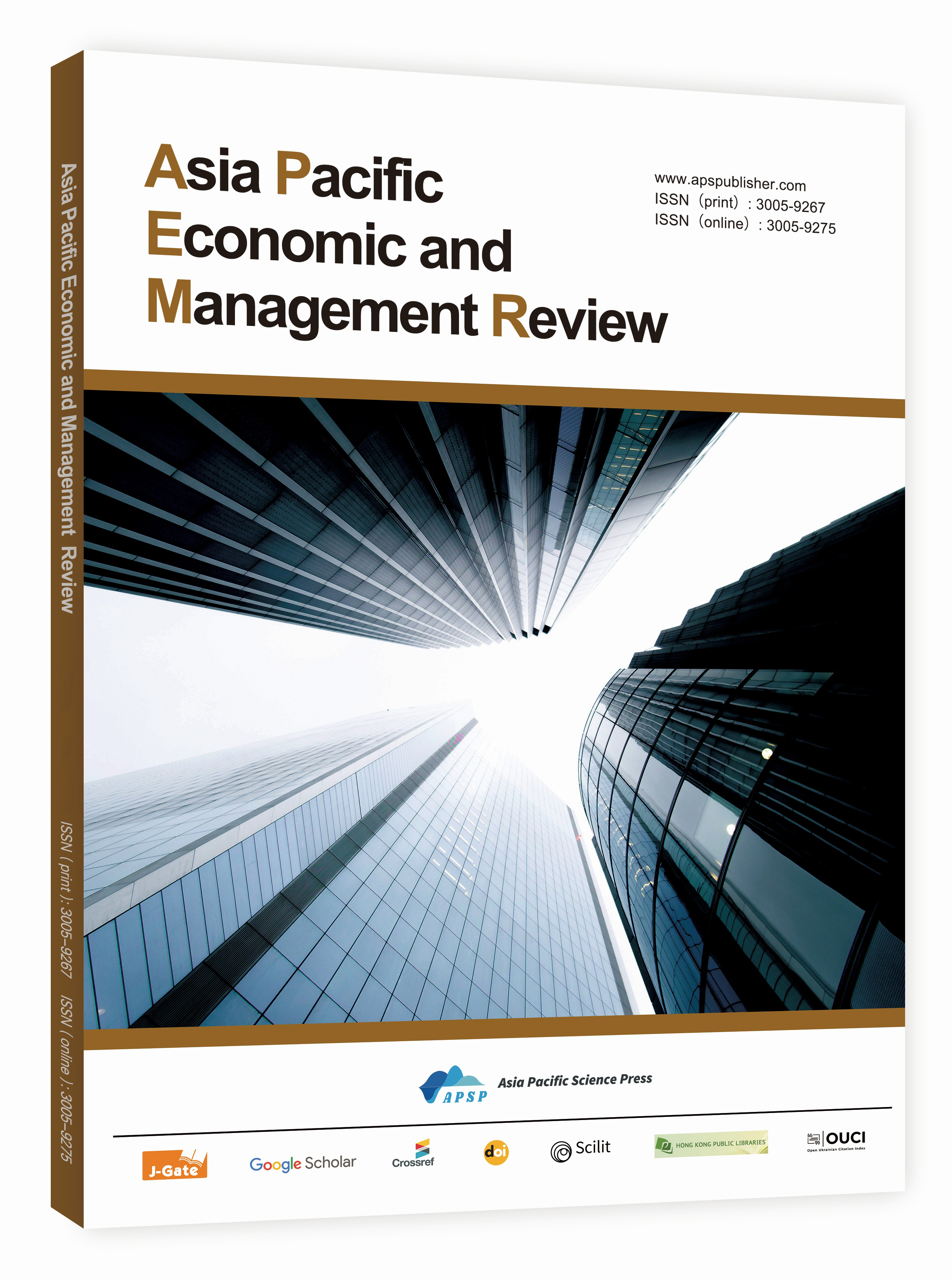Elasticity of Substitution, Technological Progress Bias and Labor Income Share: Evidence From China
DOI:
https://doi.org/10.62177/apemr.v2i2.227Keywords:
Elasticity of Factor Substitution, Technological Progress Bias, Labor Income ShareAbstract
Long-time low-level stagnation of labor income share (LIS) could lead to continuous deterioration of national income distribution status and increase the uncertainty of national development trend. A deep analysis into the root of long-time low-level stagnation of LIS is crucial to rectifying the structural disequilibrium of national income distribution and key to promoting sustainable economic growth. In view of this, this paper selects the province-level panel data of China during 2000 – 2017 for analysis. The research results show that elasticity of factor substitution (EFS) and technological progress bias (TPB) are key factors influencing LIS. With the rise of EFS, technological progress tends to be gradually biased towards capital factors and cause LIS to reduce. Meanwhile, the presence of TPB would in turn boost EFS, further causing LIS to reduce, forming a vicious circle, and leading the national economic structure to become even unbalanced. The above conclusion remains valid through the robustness test. Therefore, the government should design a series of reasonable institutions to promote the structural transformation of the national economy, rationalize the factor endowment during the production process, and make technological progress gradually biased towards labor factors, so as to improve the factor income distribution (FID) pattern.
Downloads
References
Berg, Andrew G.,and Jonathan D.Ostry."Inequality and unsustainable growth:two sides of the same coin?." IMF Economic Review 65 (2017): 792-815. https://doi.org/10.1057/s41308-017-0030-8
Bellocchi, Alessandro, and Giuseppe Travaglini. "Can variable elasticity of substitution explain changes in labor shares?."Journal of Macroeconomics 76 (2023): 103518. https://doi.org/10.1016/j.jmacro.2023.103518
Chen, Dengke, and Shiyi Chen. "Capital-labour relative price, substitution elasticity and labour income share." The Journal of World Economy 41.12 (2018): 73-97.
Grossman, Gene M., and Ezra Oberfield. "The elusive explanation for the declining labor share."Annual Review of Economics 14.1 (2022): 93-124. https://doi.org/10.1146/annurev-economics-080921-103046
Acemoglu, Daron, and Pascual Restrepo. "Robots and jobs: Evidence from US labor markets."Journal of political economy 128.6 (2020): 2188-2244. https://doi.org/10.1086/705716
Guimarães, Luís, and Pedro Mazeda Gil. "Explaining the labor share: automation vs labor market institutions." Labour Economics 75 (2022): 102146. https://doi.org/10.1016/j.labeco.2022.102146
Solow, Robert M. "A skeptical note on the constancy of relative shares." The American Economic Review 48.4 (1958): 618-631.
Denison, Edward F. "Income types and the size distribution." The American Economic Review 44.2 (1954): 254-269.
Changyuan, Luo. "Rethinking the Kardo ‘Stylized Facts’: The Share of Labor Income Revisited." The Journal of World Economy 1 (2008): 86-96.
Blanchard, Olivier J., et al. “The Medium Run.” Brookings Papers on Economic Activity,2, (1997):89–158. https://doi.org/10.2307/2534687.
Bentolila, Samuel, and Gilles Saint-Paul. "Explaining movements in the labor share." Contributions in Macroeconomics 3.1 (2003). https://doi.org/10.2202/1534-6005.1103
Sato, Ryuzo. "The estimation of biased technical progress and the production function." International Economic Review 11.2 (1970): 179-208. https://doi.org/10.2307/2525662
Klump, Rainer, and Olivier de La Grandville. "Economic growth and the elasticity of substitution: Two theorems and some suggestions." American Economic Review 91.1 (2000): 282-291. https://doi.org/10.1257/aer.90.1.282
Lu Jing, Liu Yiqun. Elasticity of Factor Substitution, Capital Expansion and Changes in the Share of Factor Returns in China’s Industrial Sector[J].Journal of World Economy, 2016, 39(03):118-143.
Ni Xujun. Research on the Influence of Elasticity of Factor Substitution on Labor Reward Share – Microscopic Evidence Based on Quantile Regression[J].Price: Theory & Practice, 2016(11):138-141.
Irmen, Andreas, and Rainer Klump. "Factor substitution, income distribution and growth in a generalized neoclassical model." German economic review 10.4 (2009): 464-479. https://doi.org/10.1111/j.1468-0475.2009.00491.x
Luo Chuliang, Ni Qingshan. Capital Deepening and Labor Income Proportion – Empirical Research Based on Industrial Enterprise Data[J]. Economic Perspectives, 2015(08):40-50.
Palivos, Theodore, and Giannis Karagiannis. "The elasticity of substitution as an engine of growth." Macroeconomic Dynamics 14.5 (2010): 617-628. https://doi.org/10.1017/S1365100509000479
Gong Min, Xin Minghui. "Industrial Structure Change and Labor Share Evolution – Based on Factors’ Alternative Elasticity and Orientation of Technical Progress ".Academic Monthly 49.12( 2017):90-102. https://doi.org/10.19862/j.cnki.xsyk.2017.12.014
Acemoglu, Daron. "Labor‐and capital‐augmenting technical change." Journal of the European Economic Association 1.1 (2003): 1-37. https://doi.org/10.1162/154247603322256756
Hicks J R. Theory of Wages [M], London: Macmillan, 1932.
David, Paul A., and Th Van de Klundert. "Biased efficiency growth and capital-labor substitution in the US, 1899-1960." The American Economic Review (1965): 357-394.
Acemoglu, Daron. "Why do new technologies complement skills? Directed technical change and wage inequality." The quarterly journal of economics 113.4 (1998): 1055-1089. https://doi.org/10.1162/003355398555838
Yuan Peng, Zhu Jinjin. Factor Market Distortion, Biased Technical Progress and the Change of Labor Share[J].Economic Review, 2019(2).
Luo Zhi, Zhou Liyun, Li Haoran. Labor Income Proportion and Biased Technical Progress[J].World Economic Papers, 2017(02):1-15.
Klump, Rainer, Peter McAdam, and Alpo Willman. "The normalized CES production function: theory and empirics."Journal of Economic surveys26.5 (2012): 769-799. https://doi.org/10.1111/j.1467-6419.2012.00730.x
Yang, Zhenbing, et al. "Improvement pathway of energy consumption structure in China's industrial sector: from the perspective of directed technical change." Energy Economics 72 (2018): 166-176. https://doi.org/10.1016/j.eneco.2018.04.003
Fellner, William. "Two propositions in the theory of induced innovations." The Economic Journal 71.282 (1961): 305-308. https://doi.org/10.2307/2228769
Li Ping, Guo Juanjuan."Foreign Investment, Capital Biased Technology Progress and Labor Share". Forum on Science and Technology in China.06(2017):137-144. https://doi.org/10.13580/j.cnki.fstc.2017.06.019
Bo-wen, L. I., and S. U. N. Shu-qiang. "Factor-Biased Technology Progress, Elasticity of Substitution and Labor Income Share." Commercial Research 56.2 (2014): 1.
Chen Xiaoling, Wu Gu, Lian Yujun."Capital-Labor Substitution Elasticity, Biased Technology Change and Factors, Income Shares in China’s Industrial Sector".Economic Science 04(2019):81-91.
Young, Andrew T. "Labor's share fluctuations, biased technical change, and the business cycle." Review of economic dynamics 7.4 (2004): 916-931. https://doi.org/10.1016/j.red.2004.07.001
Dudley, Leonard, and Johannes Moenius. "The great realignment: How factor-biased innovation reshaped comparative advantage in the US and Japan, 1970-1992." Japan and the World Economy 19.1 (2007): 112-132. https://doi.org/10.1016/j.japwor.2005.05.003
Decreuse, Bruno, and Paul Maarek. "FDI and the labor share in developing countries: A theory and some evidence." Annals of Economics and Statistics/Annales d'Économie et de Statistique 119/120 (2015): 289-319. https://doi.org/10.15609/annaeconstat2009.119-120.289
Growiec, Jakub, Peter McAdam, and Jakub Mućk. "Endogenous labor share cycles: theory and evidence."Journal of Economic Dynamics and Control 87 (2018): 74-93. https://doi.org/10.1016/j.jedc.2017.11.007
Brown, Murray, and John S. De Cani. "Technological change and the distribution of income."International Economic Review 4.3 (1963): 289-309. https://doi.org/10.2307/2525309
Yuhn, Ky-hyang. “Economic Growth, Technical Change Biases, and the Elasticity of Substitution: A Test of the De La Grandville Hypothesis.”The Review of Economics and Statistics 73.2 (1991):340–346. https://doi.org/10.2307/2109526.
Arpaia, Alfonso, Esther Pérez, and Karl Pichelmann. "Understanding labour income share dynamics in Europe."37.5(2009).:1725-3187. https://doi.org/10.2765/37596
Schlicht, Ekkehart. "Directed technical change and capital deepening: A reconsideration of Kaldor's technical progress function." Metroeconomica 67.1 (2016): 119-151. https://doi.org/10.1111/meca.12101
Yin Heng, Zhang Daoyuan, Li Hui."Elasticity of Factor Substitution, Biased Technological Progress and Rising Share of Labor Income". Finance & Trade Economics, 1-17. https://doi.org/10.19795/j.cnki.cn11-1166/f.20240008.003
Caselli, Francesco, and Wilbur John Coleman. "The world technology frontier." American Economic Review 96.3 (2006): 499-522. https://doi.org/10.1257/aer.96.3.499
Zheng Meng, Tian Yongxiao."The Elasticity of Factor Substitution and Income Distribution in Six Latin American Countries".Journal of Latin American Studies, 41. 02 (2019): 95-110+157.
Justin Lin, Pan Shiyuan, Liu Mingxing. "Technological Choice, Institution and Economic Development ". China Economic Quarterly 02 (2006): 695-714.
Romer, Paul M. "Increasing returns and long-run growth." Journal of political economy 94.5 (1986): 1002-1037. https://doi.org/10.1086/261420
Zheng Meng, Yang Xianming. "How Does Factor Substitution Militate against the Income Distribution under the Growth Mode?."Nankai Economic Studies.02 (2017): 55-75. https://doi.org/10.14116/j.nkes.2017.02.004
Chen Yong, Bo Zhe."Biased Technical Change, Industrial Structure and Change in China’s Labor Share."Shanghai Journal of Economics. 06 (2020): 56-68. https://doi.org/10.19626/j.cnki.cn31-1163/f.2020.06.006
Acemoglu, Daron, and Pascual Restrepo. "The race between man and machine: Implications of technology for growth, factor shares, and employment." American economic review 108.6 (2018): 1488-1542. https://doi.org/10.1257/aer.20160696
Zhu Lin, Wang Bo, Xu Bo."Estimation and Analysis on Factor-biased Technical Change of China."Technology Economics 35. 11 (2016): 73-78+96.
Akaev, Askar, et al. "Forecasting the labor intensity and labor income share for G7 countries in the digital age." Technological Forecasting and Social Change 167 (2021): 120675. https://doi.org/10.1016/j.techfore.2021.120675
Bergholt, Drago, Francesco Furlanetto, and Nicolò Maffei-Faccioli. "The decline of the labor share: new empirical evidence." American Economic Journal: Macroeconomics 14.3 (2022): 163-198. https://doi.org/10.1257/mac.20190365
Cao Zhanglong. Research on the Influence of Technological Progress Bias on Labor Income Share in China. 2020 Jilin University
Yang Yang, Jiang Wenhui, Zhang Weifang. "Can Ageing of Population, Biased Technology Progress Reduce the Labor Income Share in China: Theoretical and Empirical Analysis Based on Provincial Panel of China. "On Economic Problems.06 (2018): 6-13. https://doi.org/10.16011/j.cnki.jjwt.2018.06.002
Downloads
How to Cite
Issue
Section
License
Copyright (c) 2025 Yongbo Yang, Wenhan Zhu, Chang Zhu

This work is licensed under a Creative Commons Attribution-NonCommercial 4.0 International License.

















